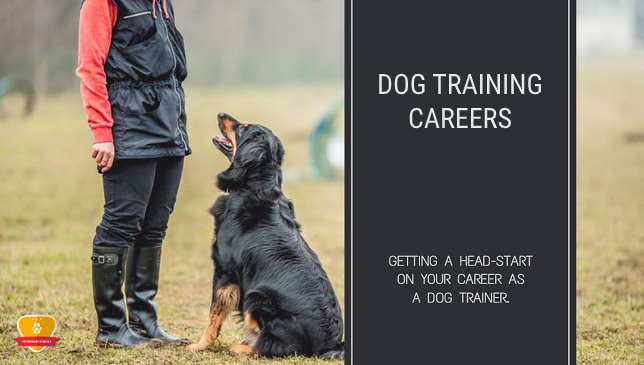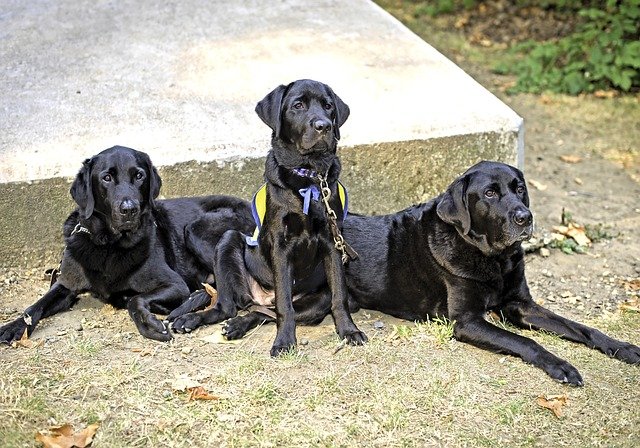- Earn your Dog Obedience Trainer certification in as little as 5 months.
- Study online at your own pace.
- Affordable tuition and flexible payment options.
- Nationally accredited college.
According to Live Science Managing Editor Jeanna Bryner,
The most frequent pets are dogs, and this is not considered unusual….
She also added that it was because they have an intelligence equal to a two-year-old.
In other words, they’re very similar to children who respond best to clearly set boundaries.
They need to know what they can and cannot do—what their limits are.
That’s why most dog training you see has to do with obedience and other basic etiquettes.
Some complex commands are thrown in there too.
All for the sake that pet owners like you have a well-behaved dog at home.
If you aspire to become a dog trainer, read on what careers are available for you.
Table of Contents
As Explained by Science
Many experiments and analyses have been conducted on dogs.
Scientists found that dogs with average intelligence could learn around 165 words, gestures, and signals.
On the other hand, above-average could learn up to 250 words
So what happens if we leave them alone without human companionship?
Then it’s possible that they might regress to their baser instincts.
This means that they’ll become wild and run in packs like wolves.
Here is where we should take into account the complex relationship between man and dog.
If we look closely, it’s not unreasonable to say that both have become attached since time immemorial.
They’ve become our companions, protectors, hunters, and workers.
Additionally, what they can be and what they can perform highly depends on their breeds.
And there’s only one way to tap into their full potential no matter their breeds.
—Consistent training and continuous learning challenges.
A Positive Approach
The approach to dog training has shifted.
No longer is it based on punishment, but encouragement and positive reinforcement.
So now, dogs have responded beautifully to training, and no longer fear the threat of punishment.
In return, dog trainers and owners get a productive day of training.
Career Option 1: Puppy Kindergarten
In puppy kindergarten, there are three important learning areas:
- Housebreaking
- Socialization
- Basic commands
Here, doing leash training at an early age help stimulate other areas of learning.
For instance, when training them on the basic commands: sit, stop, lay down.
Another area is socialization with other pups and around other people.
The good thing is that dogs show off their unique personalities at an early age.
And so owners can see if there’s any bad behavior like aggression or fear that needs to be handled.
Dog trainers agree on the crucial role dog owners play in training.
Mostly because owners also need to learn it to be able to manage their dogs well at home.
And so, trainers will impart simple yet fundamental techniques, tips, tricks, and other strategies to them.
Of course, provided that owners will follow these through every day consistently.
Career Option 2: Basic Dog Obedience Training
Obedience training aims to help owners make their dogs behave at home and outside.
The training menu has been based on research done on many dogs studying their:
- Canine behavior
- Positive messages
- Breed-specific characteristics
It’s best to start when they’re still pups, an age where they’re still active and more open to learning.
The American Kennel Club (AKC) has five basic cues owners and trainers can start with.
- Come
- Walk
- Sit
- Down
- Stay
Career Option 3: Dog Obedience Training for Specific Breeds
Every dog breed can easily learn those above-mentioned basic commands.
But there are special commands targeted at specific breeds.
And so, beyond the basics, specialty training is required.
Dog trainers approach their training differently based on knowing:
- Their baser instincts and behaviors
- Each breed’s particular behavior and personality
They’ll create and apply specific techniques into the training plan, which heavily depends on:
- The breed of dog
- Purpose of the training
Let us give you examples.
A Closer Look at Breed-Specific Dog Obedience Training
Working Dogs
Working dogs aren’t like pets or companion dogs.
They’re trained for a specific purpose, performing particular tasks.
AKC listed 37 purposely bred dogs, and to name a few, they are:
- Akita
- Alaskan malamute
- Bullmastiff
- Chinook
- Great Dane
The most popular working dog group is service dogs for disabled individuals.
Training service dogs is very strict, and only professional handlers can train them successfully.
When training them, a trainer has to pay attention to numerous characteristics.
Also, they must consider the following to better determine the right moment for pairing them with an owner.
- Breed
- Attitude and personality
- Capable of following commands
- Capable of anticipating dangerous situations
At its most basic, service dogs will:
- Lead their owner from place to place
- Stop at steps and curbs
- Avoid low-hanging roofs and branches
- Bypass any obstacles
The thing is, service dogs aren’t only trained to obey.
They’re also trained to disobey any commands deemed unsafe to protect their owners from harm.
For example, they will resist the order to cross the street when they see cars coming.
Companion Dogs
Aside from working dogs, people with disabilities also take companion dogs.
However, you should know that they’re not the same as working dogs.
Their main goal is to protect and please their owners and keep them company.
These dogs are highly trained to perform the tasks the owner is unable to complete.
For example:
- Pick an object that fell on the floor
- Open doors
- Fetch newspapers and the mail
Comfort Dogs
Comfort dogs, as the name suggests, are trained to comfort individuals, particularly children.
They’re usually smaller dogs with calm and gentle natures, and generally love to be petted and held.
Their services are needed to comfort owners during or after experiencing trauma, like a hurricane or tornado.
In many cases, comfort dogs can be seen at:
- Hospitals
- Hospice facilities
- Nursing home
They’re there to bring joy and comfort to the suffering and ailing people.
Therapy Dogs
Therapy dogs mainly help people confront the issues of their mental health.
Also, they help people with injuries with their rehabilitation treatment.
Obedience Isn’t Done in a Day
Like everything else in life, you can’t expect dogs to be obedient in just one snap.
To do whatever you want them to do.
Know that they’re born without knowing “human” rules—how we expect them to behave.
So if they want to jump on the table and grab food, then they’ll do so.
‘Cause it’s in their nature.
That’s why training is best done when they’re pups.
If possible, their mother should be their first teacher.
In this way, as they grow up, they’ll see what it means to simply be a dog.
Meaning, they’ll know firsthand how to feed and fend for themselves—even their place in the pack hierarchy.
Most of all, learn what their owners expect from them.
And you can start obedience training with simple leash training, an area that all dog breeds can learn easily.
Get your accredited and budget-friendly associate degree or career diploma entirely online!
Veterinary AssistantVeterinary TechnicianVet Office ManagerDog ObediencePet GroomingSponsored Online Programs.

